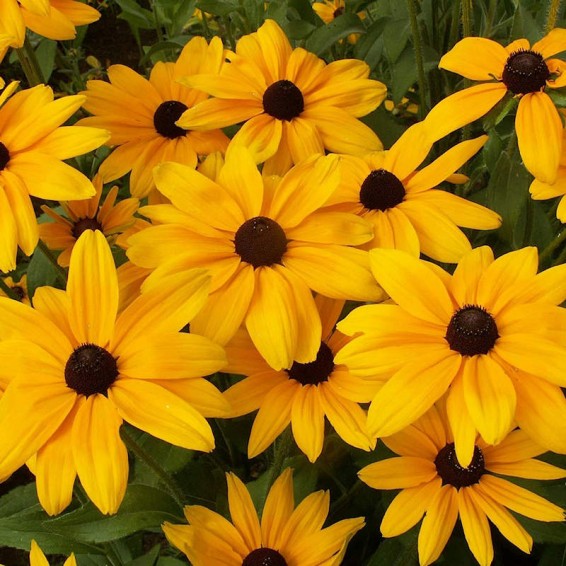Indian Summer Black Eyed Susan Seeds
- HOW TO GROW
- FAST FACTS
- REVIEWS
HOW TO GROW
Sowing: Direct sow in late fall, pressing into the surface of the soil since this plant needs light to germinate. For spring planting, mix Indian summer black-eyed Susan seeds with moist sand and store in the refrigerator for 30 days before planting. Keep the soil lightly moist until germination, which usually takes 2-3 weeks. The Indian summer black-eyed Susan seeds can also be started indoors 6-8 weeks before planting in spring. Keep seedlings lightly moist, and transplant them as soon as they have developed several leaves.
Growing: Water seedlings regularly until they become established. This plant grows very quickly and needs little care. Though it grows well in fairly dry soil, it performs best with occasional watering in dry weather. This plant usually begins blooming in its second year of growth. Mature plants tolerate heat and drought well, as well as tolerating clay or rocky soils. Deadhead for the longest blooming period. Mature plants can be divided. This plant attracts butterflies, and may self-seed.
Harvesting: For cut flowers, choose stems with flowers that have just opened. Strip the foliage that will fall below the water level, and place in water immediately.
Seed Saving: After the flower petals fall from the head, the center cone will begin to develop seed. Remove the seed heads as soon as the stem beneath the cone begins to turn dry and brown. Spread the seed heads out to dry away from direct sunlight, then separate the small seeds from the stems by rubbing them lightly. Store the cleaned Indian summer black-eyed Susan seeds in a dry, cool place.
FAST FACTS
Common Names: Black Eyed Susan
Latin Name: Rudbeckia hirta
Species Origin: US Native Wildflower
Type: Garden Flowers
Life Cycle: Annual, Biennial, Perennial
USDA Zones: 1, 2, 3, 4, 5, 6, 7, 8, 9, 10, 11, 12
US Regions: California, Mountain, Arid/Desert, Plains/Texas, Midwest, Northern, Northeast, Southeast
Seeds per Ounce: 100,000
Stratification: Cold/Wet for 4 Weeks
Germination Ease: Stratify 4 Weeks
Sunlight: Full Sun, Part Sun
Height: 36 Inches
Color: Yellow
Bloom Season: Blooms Early Summer, Blooms Late Summer, Blooms Early Fall
Uses: Attracts Pollinators, Attracts Honeybees, Attracts Butterflies, Hummingbirds, Cut Flowers, Deer Resistant
Seeds
Love all the seeds I have purchased. The Virginia stock.is awesome. Spring flowers with a scent
Great selection
Blooms in the summer time reliably.
Hope they grow here
Love the packaging. I won't plant these until late-fall/early-winter and then won't know until next year.
Golden.
We will plant these next spring. Really looking forward to it.
Multi year multi item customer
Always reliable seeds. Always germinate in a good percent; good count . Been buying from Everwilde for many years, never a problem.
DESCRIPTION
HOW TO GROW
Sowing: Direct sow in late fall, pressing into the surface of the soil since this plant needs light to germinate. For spring planting, mix Indian summer black-eyed Susan seeds with moist sand and store in the refrigerator for 30 days before planting. Keep the soil lightly moist until germination, which usually takes 2-3 weeks. The Indian summer black-eyed Susan seeds can also be started indoors 6-8 weeks before planting in spring. Keep seedlings lightly moist, and transplant them as soon as they have developed several leaves.
Growing: Water seedlings regularly until they become established. This plant grows very quickly and needs little care. Though it grows well in fairly dry soil, it performs best with occasional watering in dry weather. This plant usually begins blooming in its second year of growth. Mature plants tolerate heat and drought well, as well as tolerating clay or rocky soils. Deadhead for the longest blooming period. Mature plants can be divided. This plant attracts butterflies, and may self-seed.
Harvesting: For cut flowers, choose stems with flowers that have just opened. Strip the foliage that will fall below the water level, and place in water immediately.
Seed Saving: After the flower petals fall from the head, the center cone will begin to develop seed. Remove the seed heads as soon as the stem beneath the cone begins to turn dry and brown. Spread the seed heads out to dry away from direct sunlight, then separate the small seeds from the stems by rubbing them lightly. Store the cleaned Indian summer black-eyed Susan seeds in a dry, cool place.
FAST FACTS
Common Names: Black Eyed Susan
Latin Name: Rudbeckia hirta
Species Origin: US Native Wildflower
Type: Garden Flowers
Life Cycle: Annual, Biennial, Perennial
USDA Zones: 1, 2, 3, 4, 5, 6, 7, 8, 9, 10, 11, 12
US Regions: California, Mountain, Arid/Desert, Plains/Texas, Midwest, Northern, Northeast, Southeast
Seeds per Ounce: 100,000
Stratification: Cold/Wet for 4 Weeks
Germination Ease: Stratify 4 Weeks
Sunlight: Full Sun, Part Sun
Height: 36 Inches
Color: Yellow
Bloom Season: Blooms Early Summer, Blooms Late Summer, Blooms Early Fall
Uses: Attracts Pollinators, Attracts Honeybees, Attracts Butterflies, Hummingbirds, Cut Flowers, Deer Resistant
Reviews
Review
Seeds
Love all the seeds I have purchased. The Virginia stock.is awesome. Spring flowers with a scent
Review
Great selection
Blooms in the summer time reliably.
Review
Hope they grow here
Love the packaging. I won't plant these until late-fall/early-winter and then won't know until next year.
Review
Golden.
We will plant these next spring. Really looking forward to it.
Review
Multi year multi item customer
Always reliable seeds. Always germinate in a good percent; good count . Been buying from Everwilde for many years, never a problem.






